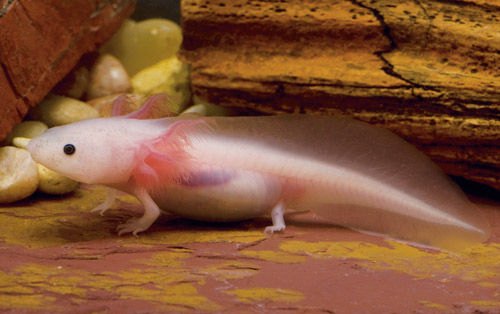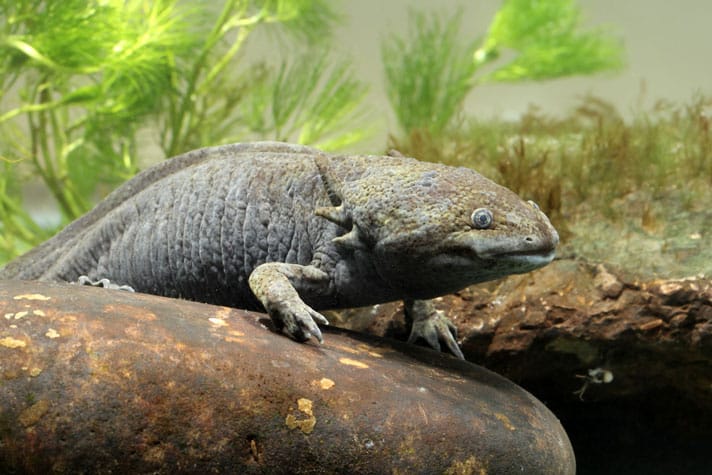Care sheet for the Axolotl Ambystoma mexicanum.
Axolotls (Ambystoma mexicanum)
Axolotls are large salamanders that come from the remnants of lakes Xochimilco and Chalco in Mexico City, Mexico. Axolotls live their entire lives in water, never emerging onto land. Axolotl care requirements are minimal, and provided temperature and water flow are well controlled, they are hardy, easy-to-care-for captives that breed readily in captivity. It is difficult to think of a more unusual display animal than the axolotl, and its bold and tame nature makes it an interactive pet.
Axolotl Availability
Axolotls are often available from private breeders, often via the Internet. Axolotls are not commonly available in reptile stores or at reptile shows, owing to their incompatibility with most reptile-friendly temperatures. Some suppliers may be able to special order them for you, but generally the best sources for healthy axolotls are other hobbyists.

Photo credit: John Clare
Leucistic axolotls are white with dark eyes, and sometimes they have a few black markings along the top of the body.
Axolotl Size
Most axolotls reach about 10 inches total length (from the tip of the nose to the end of the tail). A few will pass 12 inches, but this is rare. I have personally seen and photographed a 17-inch axolotl that had to be seen to be believed, but such monsters are highly unusual. Axolotls reach sexual maturity when they reach about 8 inches. This can be in as few as six months, but generally it takes about a year of good care to reach this size.
Axolotl Life Span
Axolotls have been known to live past 20 years, but it is unusual to find an individual older than 10 years.
Axolotl Housing
A common 10-gallon reptile aquarium can accommodate a single adult axolotl, but due to the large amount of waste produced by these messy creatures, a 20-gallon aquarium is a safer choice. Axolotls do not emerge from the water, so a land area would go unused. Fill the aquarium to the depth of your choice, but it will be easier to maintain good water parameters when the aquarium is filled, as you would for aquarium fish. A lid or aquarium hood should be kept in place at all times because axolotls have been known to jump out of their aquariums.
A filter will help maintain safe water parameters. The best choice is an external canister filter, such as the Zoo Med Turtle Clean Canister Filter, but ensure the water outlet to the aquarium is fitted with a spray bar or other flow-spreading outlet. This is necessary because axolotls do not tolerate distinct water flow like fish. Axolotls that live in a noticeable water flow for a few months will go off food and develop stress-related diseases. Lack of appetite and forward-curled gills are usually a sign of stress from too much water flow.
Axolotl Lighting and Temperature
Like the vast majority of amphibians, axolotls do not require lighting, and indeed, new axolotls may be shy if kept under bright lighting, though they will become accustomed to it if provided with some hiding places (the usual aquarium “furniture” such as caves, wood, plants, etc.). Lighting is generally for our viewing pleasure and for the benefit of aquarium plants and salamander habitat supplies. Choose a plant-friendly bulb, such as those sold for freshwater aquarium fish. Keep in mind that lighting fixtures often generate a lot of excess heat and this can be detrimental to axolotls.
Temperatures up to the low 70s Fahrenheit are tolerated well by axolotls. An ideal temperature range is the low to mid 60s. Temperatures above 74 degrees will invariably lead to heat stress, loss of appetite and death. If you cannot provide year-round temperatures below this limit, axolotls are not the ideal pet for your circumstances. If you must have an axolotl but you have temperature problems, consider buying an aquarium chiller for the warmer parts of the year.
Axolotl Substrate
The ideal substrate for axolotls is aquarium-safe sand like Aqua Terra’s Aquarium & Terrarium Sand. Axolotls have a bad habit of ingesting gravel and mouth-sized objects if they are available. This can lead to gut impactions and the death of the axolotl. If you wish to use gravel, consider large pebbles instead, such as Exo Terra’s Large Natural Turtle Pebbles. Anything the size of an axolotl’s head or smaller can and will be consumed!
Salamander substrate is not essential – for Axolotls. Many keepers use no substrate at all – but it is certainly more pleasing to the eye in a display aquarium if a substrate is used, and it will also help to keep water parameters stable by providing surface area for beneficial bacteria.
Axolotl Food
Good staple foods for axolotls include live reptile food such as nightcrawlers (large earthworms) and store bought frozen bloodworm cubes. Good treat foods for axolotls include frozen shrimp from the supermarket (cooked), and lean pieces of beef and chicken. Avoid live food such as feeder fish because of the risk of parasite and disease transmission – axolotls are vulnerable to many fish diseases and parasites. Pinkie mice and other fatty foods are best used only as a rare treat for axolotls and preferably not at all.
As is the case with most salamanders, axolotls have no need of vitamin/mineral supplementation, and indeed it would be hard to deliver this to an aquatic animal. In my experience, axolotls fed solely on nightcrawlers will never develop any vitamin or mineral deficiencies.
Axolotl Water and Quality
Tap water is fine for axolotls, provided it is pretreated with aquarium water conditioner to remove chlorine and chloramines. Axolotls are far more forgiving than aquarium fish when it comes to water quality, but a good filter and regular water changes should be employed nonetheless. If you’ve ever kept aquarium fish, follow a similar routine.
Ideally, a new aquarium and filter should be allowed to cycle for several weeks prior to the introduction of axolotls to let the water conditions settle and filter bacteria develop. Be sure to keep an eye on water parameters using the water test kits sold at aquarium stores.
Axolotl Handling and Temperament
Axolotls have virtually no true bone in their bodies, particularly when young. Much of their skeleton is made up of cartilage. Axolotls are delicate and soft-bodied amphibians with permeable skin. As such, axolotls should not be handled unless absolutely necessary (they are tricky to catch in a net). If you use a net to move an axolotl, avoid nets with mesh that would let an axolotl’s fingers get damaged. Use a soft, very fine-mesh net.
Young axolotls tend to nip at or bite off the legs and gills of their tankmates, so youngsters should only be kept together if fed well and given plenty of space. Axolotls larger than 5 inches tend to be safer tankmates, and adults will rarely have any altercations. Contrary to the advice of some sources, axolotls are not social animals and do not benefit from having a companion axolotl. Keeping multiple axolotls is purely for the keeper’s benefit and for breeding.
Due to the tendency of nipping, fish should not be kept with axolotls. In fact, an axolotl aquarium should contain only axolotls!
John Clare is the author of Axolotl.org, and the founder of Caudata.org and FrogForum.net.


